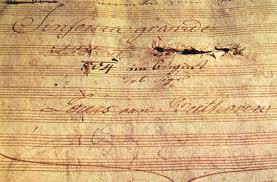
With a title like A Pastoral Symphony, you might expect Ralph Vaughan Williams’ Third Symphony, completed in 1922, to evoke bubbling brooks and the quiet hedgerows of England’s “green and pleasant land.” But listen, and you’ll hear music which, instead, suggests a melancholy alienation from nature. The music feels strangely hazy and shell-shocked. Its pastures are the battlefields of the First World War, not the bucolic scenes of Beethoven’s Sixth Symphony or a Schubert song.
At the age of 41, Vaughan Williams served in the war as an ambulance driver for the Royal Army Medical Corps. This was the moment when the world caught its first, real glimpse of weapons of mass destruction. New, dehumanizing technology included tanks, poison gas, flame throwers and primitive air power. Soldiers were reduced to “killing machines” as trench warfare and the concept of attrition wiped away any pretense of gallant heroism. Vaughan Williams described the Symphony’s genesis, saying,
It’s really wartime music – a great deal of it incubated when I used to go up night after night in the ambulance wagon at Ecoivres and we went up a steep hill and there was wonderful Corot-like landscape in the sunset. It’s not really lambkins frisking at all, as most people take for granted.
A Pastoral Symphony can be heard as nature’s lament. It seems rooted in the magnificent permanence of nature and simultaneously human separation from nature. In the context of music history, it may represent one of the final attempts to connect with the Romantic pasture of the eighteenth and nineteenth centuries. Considering Ray Kurzweil’s theory of exponential technological growth, think about the ways in which music permanently changed in the second half of the twentieth century, with influences such as the automobile, the atomic bomb and the computer. Even Mahler’s nine symphonies gradually progressed from bird songs (in the First Symphony) towards dissonance (in the Ninth).
In some ways, Vaughan Williams’ Pastoral Symphony shakes up our concept of symphonic form. Most symphonies develop through linear motion, leading to a climax. This music, built on modes, parallel harmony, and the pentatonic scale, floats into more static territory. Each of the Pastoral Symphony’s movements ends by trailing off, denying us a clear sense of resolution.
The first movement (Molto moderato) is a restless sonic landscape of constantly shifting Impressionistic color and harmony. As each event unfolds into the next, our sense of key and tonal center seems to continuously slip away. Everything feels elusive, as if we’re chasing shadows.
Consider the musical colors created as woodwind lines move in and out of the thickly layered string sound (2:58, for example). Also, listen for the oboe and English horn, which evoke the traditional sounds of the pasture.
Listen to the chord at 1:36 and notice the way it stops the music in its tracks. You’ll hear this ominous hint of darkness return throughout the movement, remaining inescapable and unresolved.
In the middle of the second movement, a trumpet cadenza suggests a battlefield bugle call. Vaughan Williams intended it to be played on a valveless, “natural” trumpet.
It’s the final movement which ultimately makes A Pastoral Symphony feel so unsettling. The human voice suddenly emerges at the opening of the movement in the form of the soprano’s wordless, pentatonic lament. As the movement progresses, the music seems to be reaching for a moment of transcendent resolution. But at 7:03, the bottom falls out and we’re again confronted with the soprano’s opening line, this time in the strings. At the end of the movement, we hear the Symphony’s first true moment of resolution. Then the tonal center begins to dissolve. The soprano’s lament returns, fading into eternity.
This performance, with the Hallé Orchestra and conductor Sir Mark Elder, is part of the brand new recording I featured last week:
1. Molto Moderato:
https://www.youtube.com/watch?v=s3OBGTUcHtU
2. Lento moderato-Moderato maestoso:
https://www.youtube.com/watch?v=82oYq0cvfwc
3. Moderato pesante:
https://www.youtube.com/watch?v=OZrntM0r3aw
4. Lento:
https://www.youtube.com/watch?v=1t3pIR8Q8Rc
[unordered_list style=”tick”]
[/unordered_list]

